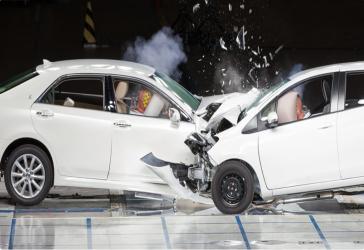
When two family cars, both the same make and model but made 17 years apart, went head to head in a crash safety test, the results showed just how far car safety has come.
The 1998 model received less than half a point out of a possible 16 points, with sensors showing that passengers would have sustained serious head, chest and leg injuries. The 2015 model scored 13 points out of 16, and passengers would have walked away with minor injuries at worst. The results are a clear demonstration of just how much the testing regime has helped car manufacturers improve safety, and a vivid illustration of how many lives are being saved.
Cutting deaths
Improvements in technology have dramatically reduced deaths from vehicle collisions in wealthier countries in which the newest vehicles are most likely to be bought and driven. According to the World Health Organization, high income countries accounted for just 10% of the 1.25 million deaths caused by road traffic crashes every year, even though they account for nearly half of the world’s vehicles. Europe offers a good illustration of just how far standards have come in recent years. Crash fatalities in the EU fell by 43% in just nine years between 2001 and 2010. The EU death rate for road collisions in 2016 was just 50 deaths per one million inhabitants – compared to a global rate of 174 per million.
Cutting edge
Low death rates in Europe and countries like Japan, which has 47 deaths per million, have been achieved by a combination of improvements in technology and increasingly stringent safety tests. Crash testing has come a long way since Alderson Research Labs Sierra Engineering developed “Sierra Sam”, the first crash test dummy, in 1949. Today the dummies come in variety of sizes, equipped with sensors to monitor the wide range of collision impacts that are now examined by authorities in safety tests. Vehicle manufacturers must test all of their components against a variety of impact scenarios.
Some of this now is done virtually, usually in the product development stage. Each component can be virtually crashed using a computer software model of the car. This helps ensure the car and its components meet safety standards for a range of different crash scenarios even before the car is assembled.
But nothing will ever be able to assess safety like a real-world test situation.

Get real
The G-simulator is a car crash simulator made by Mitsubishi Heavy Industries. The computer controlled hydraulic servo system is used in the research and development of seats and seatbelts, air bags and headrests, doors and car interiors.
The system allows a wide variety of pressures, and therefore crash impacts, simulating anything from a frontal collision at high speed to a minor rear-end bump.
One of the most notable developments since the first G simulator was release in 1997 is the ability to test pitching impacts – in other words, seeing what happens when a car is lifted off the ground in a crash.
The simulator’s pitching allows the vehicle to be shaken back-and-forth, bounced up-and-down and even rotated vertically. This gives much greater accuracy to a collision test and has allowed manufacturers to see exactly how their products react.
The future
Testing regimes will continue to push for ever-safer vehicles, driving the development of ever- more complex technologies to protect us.
At every stage those developments will need to be thoroughly tried and tested to ensure they are doing their job.
Despite the huge strides in safety technology in recent years, this is a job that will never be ‘done’.
There will always be new ideas that need to be put through ever more demanding tests to ensure our roads keep on getting safer.
Source : https://spectra.mhi.com/crash-testing-is-not-for-dummies
